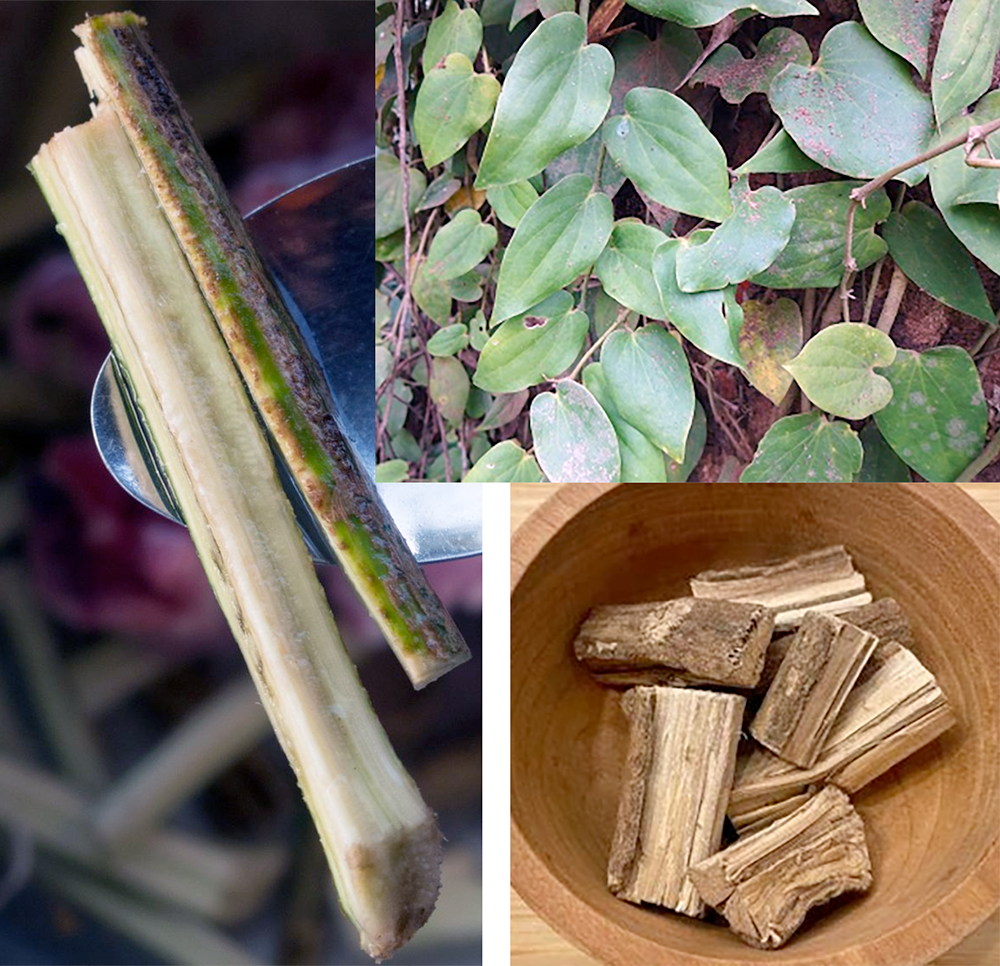FabulousFusionFood's Spice Guide for Lao Chilli Wood Home Page
 Fresh bark, climbing
vine and dried chips
of Lao chilli wood,
Piper
ribesioides.
Fresh bark, climbing
vine and dried chips
of Lao chilli wood,
Piper
ribesioides.
Welcome to the summary page for FabulousFusionFood's Spice guide to Lao Chilli Wood along with all the Lao Chilli Wood containing recipes presented on this site, with 1 recipes in total.
This is a continuation of an entire series of pages that will, I hope, allow my visitors to better navigate this site. As well as displaying recipes by name, country and region of origin I am now planning a whole series of pages where recipes can be located by meal type and main ingredient. This page gives a listing of all the Cornish recipes added to this site.
These recipes, all contain as a major flavouring.
Lao chilli wood, known as mai sakhaan (Lao: ໄມ້ ສະຄ້ານ, Lao pronunciation: [sa.kʰâːn]) and also known as pepper wood in English is a is a species of black pepper plant belonging to the Piperaceae family. The woody vine or stem of the plant has a hot, peppery and chilli flavour, with a lingering aftertaste and slightly numbing sensation to the tongue. It is commonly used in Lao cuisine both in Laos and the predominately Lao ethnic region of Northeastern Thailand. It is the most important ingredient in Laos' famous Or lam (see recipe links). Its berries are sometimes pressed for an oil that is also used as a spice in cooking. The plant is also used medicinally.
Instead of collecting its peppercorns, spice harvesters focus on the wood of the vine itself. When cut into fine splinters (usually no longer than an inch and a half) and added to soups or stews, the vine imparts a hot, peppery flavour with sharp chili hints and a numbing effect on the lips and tongue that's reminiscent of Sichuan pepper. Both young vines and mature wood are equally valuable for their flavour.
Piper ribesioides, is a lesser known woody member of the pepper family and presents as an evergreen, climbing shrub producing very stout stems. It is native to: Andaman Islands, Assam, Cambodia, India, Laos, Malaysia, Myanmar, Sri Lanka, Sumatra, Thailand, Vietnam. It is typically found in lowland forests.
Lao chilli wood is always sold and used fresh. Indeed, it will dry out and turn black in a short time and it's best to store, tightly wrapped, in the freezer. Note that if you can't get hold of the sakhan, you can approximate the taste and effects by combining the following in a tea infuser: 1 tsp black peppercorns, 5 Sichuan peppercorns, 1 dried red chilli, 1 celery leaf. Drop the infuser into your stew/curry at the same point as the recipe calls for the Lao chilli wood and fish out near the end of cooking.
In the UK, rooted plants can be purchased from specialist nurseries and are available for growth in terraria, meaning that you can grown your own portions of this unusual spice.
This is a continuation of an entire series of pages that will, I hope, allow my visitors to better navigate this site. As well as displaying recipes by name, country and region of origin I am now planning a whole series of pages where recipes can be located by meal type and main ingredient. This page gives a listing of all the Cornish recipes added to this site.
These recipes, all contain as a major flavouring.
Lao chilli wood, known as mai sakhaan (Lao: ໄມ້ ສະຄ້ານ, Lao pronunciation: [sa.kʰâːn]) and also known as pepper wood in English is a is a species of black pepper plant belonging to the Piperaceae family. The woody vine or stem of the plant has a hot, peppery and chilli flavour, with a lingering aftertaste and slightly numbing sensation to the tongue. It is commonly used in Lao cuisine both in Laos and the predominately Lao ethnic region of Northeastern Thailand. It is the most important ingredient in Laos' famous Or lam (see recipe links). Its berries are sometimes pressed for an oil that is also used as a spice in cooking. The plant is also used medicinally.
Instead of collecting its peppercorns, spice harvesters focus on the wood of the vine itself. When cut into fine splinters (usually no longer than an inch and a half) and added to soups or stews, the vine imparts a hot, peppery flavour with sharp chili hints and a numbing effect on the lips and tongue that's reminiscent of Sichuan pepper. Both young vines and mature wood are equally valuable for their flavour.
Piper ribesioides, is a lesser known woody member of the pepper family and presents as an evergreen, climbing shrub producing very stout stems. It is native to: Andaman Islands, Assam, Cambodia, India, Laos, Malaysia, Myanmar, Sri Lanka, Sumatra, Thailand, Vietnam. It is typically found in lowland forests.
Lao chilli wood is always sold and used fresh. Indeed, it will dry out and turn black in a short time and it's best to store, tightly wrapped, in the freezer. Note that if you can't get hold of the sakhan, you can approximate the taste and effects by combining the following in a tea infuser: 1 tsp black peppercorns, 5 Sichuan peppercorns, 1 dried red chilli, 1 celery leaf. Drop the infuser into your stew/curry at the same point as the recipe calls for the Lao chilli wood and fish out near the end of cooking.
In the UK, rooted plants can be purchased from specialist nurseries and are available for growth in terraria, meaning that you can grown your own portions of this unusual spice.
The alphabetical list of all Lao Chilli Wood recipes on this site follows, (limited to 100 recipes per page). There are 1 recipes in total:
Page 1 of 1
| Or Lam Origin: Laos |
Page 1 of 1